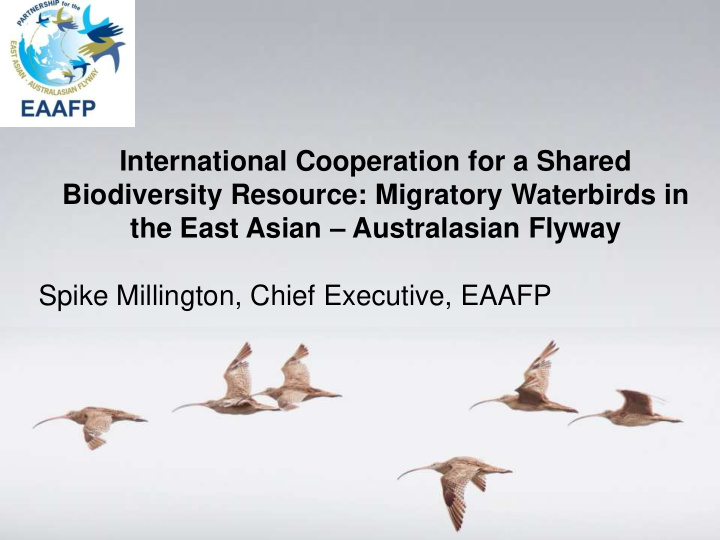



International Cooperation for a Shared Biodiversity Resource: Migratory Waterbirds in the East Asian – Australasian Flyway Spike Millington, Chief Executive, EAAFP
Nine global flyways of migratory waterbirds
Minimum 50 million individuals of 200 waterbirds species the highest number of IUCN threatened bird species: 33 Highest number of declining species (annual declines of 9% for some shorebirds)
Projected population losses of three shorebird species given current rates of decline of 5-9% per year after Amano et al . 2010 and Wilson et al. 2011
Slipping Away ..
Population time to extinction in Spoon-billed Sandpiper given current rate of decline of 26.4% per year EXTINCT BY 2020 IF NO ACTION IS TAKEN after Zockler et al . 2010
Habitat loss and degradation is the major factor responsible for waterbird declines in EAAF
Available at: www.iucn.org/asiancoastalwetlands
Migration of Spoon-billed Sandpiper Chukotka Russia Climate change impacts increased predation Indiscriminate hunting, oil development China Habitat loss Coastal reclamation Subsistence trapping
Spoon-billed Sandpiper CR • China: Rudong (S. Jiangsu) unprotected • China: Xitou (Guangdong) unprotected • DPRK: unknown • RoK: Yubu-do unprotected • Myanmar: Gulf of Mottama unprotected • Vietnam: Xuan Thuy NP protected • Thailand: Inner Gulf unprotected • Bangladesh: Sonadia unprotected
Yellow Sea Ecoregion China: 1.87% protected DPRK: 0.01% protected ROK: 1.44% protected Other Intertidal Areas Myanmar: N Bay of Bengal 0.22% protected
Great Knot • 7.4% of breeding grounds protected • 11.5% of non-breeding grounds But only • 0.03% of stopover sites
A transboundary issue requiring Russia USA (Alaska) an international response Mongolia China North Korea South Korea Japan Philippines Bangladesh Thailand Cambodia Indonesia Laos Myanmar Vietnam Malaysia Singapore Brunei Darussalam East Timor Papua New Guinea Australia New Zealand
EAA Flyway Partnership Launched in Indonesia in Nov. 2006 • Voluntary (non-binding) arrangement • Open to Governments, international non- government and intergovernmental organisations, private sector • Based on 5 Objectives, 5-year Strategic Plan statements • Secretariat is based on Incheon, South Korea and supported by the Government of Korea and Incheon City Government
What is EAAFP? Govments (15) Countr ntry Austr tralia ia Indon ones esia ia Japa pan The Ph Philip lippin pines es R.of of Korea Russia ia Singa gapo pore US USA Cambo bodia dia China ina Bang ngla lade desh Thaila iland nd Mongo golia ia New Ze Ne Zeala land nd Mala laysia ia Inter-Government organisations (4) Conservation of Arctic Flora and Fauna International NGOs (10)
The Partnership’s Objectives 1. Develop the Flyway Network of Sites of international importance for migratory waterbirds. 2. Enhance communication, education and public awareness of the values of migratory waterbirds and their habitats 3. Enhance flyway research and monitoring activities, build knowledge and promote exchange of information on waterbirds and their habitats 4. Build the habitat and waterbird management capacity of natural resource managers, decision makers and local stakeholders 5. Develop flyway wide approaches to enhance the conservation status of migratory waterbirds .
Flyway Site Network Flyway Network Sites (123) Important Potential sites (Approx. 950)
The countries along the EAAF have made commitments to global biodiversity targets under several key multilateral environmental agreements, but it will only be possible for the countries to meet these commitments if they halt the declining trends in species populations and habitat availability and quality.
Target 11: By 2020, min. 17% of terrestrial and inland water, and 10% of coastal and marine areas, especially areas of particular importance for biodiversity and ecosystem services, are conserved through effectively and equitably managed, ecologically representative and well-connected systems of protected areas and other effective area-based conservation measures, and integrated into the wider landscape and seascapes
Target 12: By 2020 the extinction of known threatened species has been prevented and their conservation status, particularly of those most in decline, has been improved and sustained
Thank you for your attention VISIT US @ www.eaaflyway.net
Recommend
More recommend